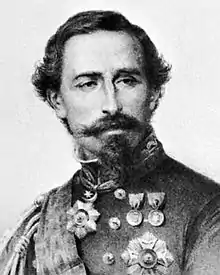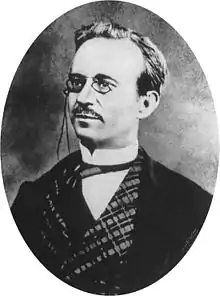1865 Italian general election
General elections were held in Italy on 22 October 1865, with a second round of voting on 29 October.[1] It was the second one in the history of Italy.
| |||||||||||||||||||||||||||||
All 443 seats to the Chamber of Deputies of the Kingdom of Italy | |||||||||||||||||||||||||||||
|---|---|---|---|---|---|---|---|---|---|---|---|---|---|---|---|---|---|---|---|---|---|---|---|---|---|---|---|---|---|
| |||||||||||||||||||||||||||||
| |||||||||||||||||||||||||||||
Electoral campaign
The Historical Right was led by the former Prime Minister of the Kingdom of Sardinia, Alfonso Ferrero La Marmora, a long-time general who fought during the Italian unification.
On the other hand, the bloc of the Historical Left was led by Urbano Rattazzi, a liberal politician who was between the founders of the Italian left-wing parliamentary group.
In opposition to the two main blocs there were a third party known as The Extreme, a far-left coalition, under the leadership of Giuseppe Mazzini, an Italian revolutionary and a key figure of the Unification.
On 22 and 29 October, only 504,263 men of a total population of around 23 million were entitled to vote.[2] Right-wing candidates emerged as the largest bloc in Parliament with around 41% of the 443 seats.[3] They were largely aristocrats representing rentiers from the north of the country, and held moderate political views including loyalty to the crown and low government spending;[4] the general La Marmora was appointed Prime Minister by the king Victor Emmanuel II.
Parties and leaders
Results
 | |||||
| Party | Votes | % | Seats | +/− | |
|---|---|---|---|---|---|
| Historical Right | 114,208[lower-alpha 1] | 42.0 | 183 | −159 | |
| Historical Left | 98,708[lower-alpha 1] | 36.3 | 156 | +94 | |
| Historical Far Left | 13,242[lower-alpha 1] | 4.9 | 15 | +1 | |
| Independents | 45,792[lower-alpha 1] | 16.8 | 89 | – | |
| Invalid/blank votes | 12,888 | – | – | – | |
| Total | 271,923 | 100 | 443 | ±0 | |
| Registered voters/turnout | 504,263 | 53.9 | – | – | |
| Source: Corriere della Sera | |||||
- Estimate
References
- Dieter Nohlen & Philip Stöver (2010) Elections in Europe: A data handbook, p1047 ISBN 978-3-8329-5609-7
- Nohlen & Stöver, p1049
- Nohlen & Stöver, p1082
- Nohlen & Stöver, p1028


